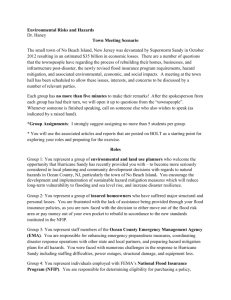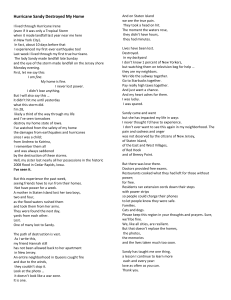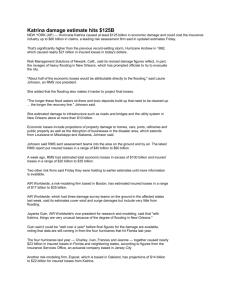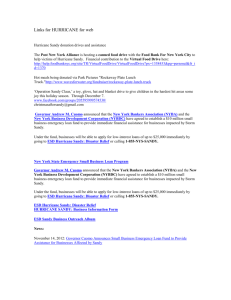Sandy-030113 - Insurance Information Institute
advertisement
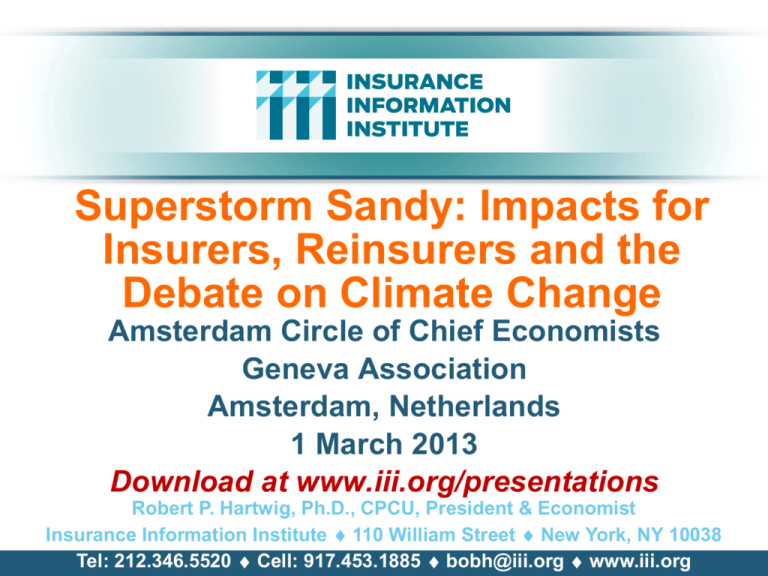
Superstorm Sandy: Impacts for Insurers, Reinsurers and the Debate on Climate Change Amsterdam Circle of Chief Economists Geneva Association Amsterdam, Netherlands 1 March 2013 Download at www.iii.org/presentations Robert P. Hartwig, Ph.D., CPCU, President & Economist Insurance Information Institute 110 William Street New York, NY 10038 Tel: 212.346.5520 Cell: 917.453.1885 bobh@iii.org www.iii.org Presentation Outline I. Summary of Superstorm Sandy’s Impact on the Insurance Industry II. Impact on the Discussion Debate on Climate Change 2 Hurricane Sandy: Summary of Insurance Impacts Sandy Will Become One of the Most Expensive Events in Global Insurance History 3 Top 12 Most Costly Hurricanes in U.S. History (Insured Losses, 2012 Dollars, $ Billions) 10 of the 12 most costly hurricanes in insurance history occurred over the past 9 years (2004—2012) Hurricane Sandy could become the 3rd costliest hurricane in US insurance history $60 $50 $40 $30 Hurricane Irene became the 12th most expensive hurricane in US history in 2011 $48.7 $25.6 $20.0 $20 $10 $5.6 $6.7 $7.8 $8.7 $9.2 $4.4 $5.6 Irene (2011) Jeanne (2004) Frances (2004) Rita (2005) Hugo (1989) Ivan (2004) Charley (2004) $11.1 $13.4 $0 Wilma (2005) Ike (2008) Sandy* (2012) *Estimate as of 1/18/13 based on estimates of catastrophe modeling firms and reported losses as of 2/26/13. Sources: PCS; Insurance Information Institute inflation adjustments to 2012 dollars using the CPI. Andrew (1992) Katrina (2005) 4 Hurricane Sandy: Claim Payments to Policyholders, by State ($ Thousands) $12,000 $10,000 $9,600 $8,000 $6,300 TOTAL = $18.75 BILLION At $9.6B and $6.6B, respectively, NY and NJ suffered, by far, the largest losses from Hurricane Sandy $6,000 $4,000 $2,000 $700 $500 $410 $295 $292 $210 $103 $84 $58 $57 $55 $37 $36 $0 NY NJ PA CT MD VA OH MA RI $13 DE WV NC NH DC ME VT Insurers Will Pay at Least $18.75 Billion to 1.52 Million Policyholders Across 15 States and DC in the Wake of Hurricane Sandy Sources: Catastrophe loss data is for Catastrophe Serial No. 90 (Oct. 28 – 31, 2012) from PCS as of Jan. 18, 2013; Insurance Information Institute . 5 Hurricane Sandy: Number of Claims by Type* Total Claims = 1.52 Million* Commercial , 202,500 , 13% Auto, 250,500 , 16% Sandy is a high HO frequency, (relatively low) severity event (avg. severity <50% Katrina) Hurricane Sandy resulted in an estimated 1.52 million privately insured claims resulting in an estimated $18.75 to $25 billion in insured losses. Hurricane Katrina produced 1.74 million claims and $48.7B in losses (in 2012 $) Homeowner , 1,067,000 , 71% *PCS claim count estimate s as of 1/18/13. Loss estimate represents PCS total ($18.75B) and upper end of range estimates by risk modelers RMS, Eqecat and AIR. All figures exclude losses paid by the NFIP. Source: PCS; AIR, Eqecat, AIR Worldwide; Insurance Information Institute. 6 Hurricane Sandy: Insured Loss by Claim Type* ($ Millions) Total Claim Value = $18.75 Billion* Commercial , $9,024 , 48% Auto, $2,729 , 15% Although Commercial Lines accounted for only 13% of total claims, they account for 48% of all claim dollars paid. In most hurricanes, Commercial Lines accounts for about 1/3 of insured losses. Homeowner , $6,997 , 37% *PCS insured loss estimates as of 1/18/13. Catastrophe modeler estimates range up to $25 billion. All figures exclude losses paid by the NFIP. Source: PCS; Insurance Information Institute. 7 Hurricane Sandy: Value of Homeowners Claims Paid, by State* ($ Millions) Hurricane Sandy All Other, $1,797 , 26% •Estimated 1,067,000 homeowners claims** •$7.0 billion in insured losses. •Average loss per claim is $6,558 •Claims in NJ estimated at $2.5 billion (36%) and $2.7 billion in NY (38%) New Jersey, $2,500 , 36% *Preliminary as of 1/18/13. Source: PCS. New York, $2,700 , 38% 8 Homeowners Insurance Combined Ratio: 1990–2014F Record tornado activity 158.4 170 160 Hurricane Sandy 106.8 105.5 118.0 122.2 106.7 105.8 116.9 95.7 89.0 90 100.3 94.4 109.3 121.7 111.4 108.2 109.4 112.7 118.4 1 Hurricane Ike 98.2 100 101.0 110 113.6 120 117.7 130 113.0 140 121.7 150 80 90 91 92 93 94 95 96 97 98 99 00 01 02 03 04 05 06 07 08 09 10 11 12F13F14F Homeowners Performance Deteriorated in 2011/12 Due to Large Cat Losses. Extreme Regional Variation Can Be Expected Due to Local Catastrophe Loss Activity Sources: A.M. Best (1990-2013F);Conning (2014F); Insurance Information Institute. 9 Hurricane Sandy: Number of Auto Claims by State* All Other, 40,500 , 16% Hurricane Sandy •Estimated 250,500 vehicle claims •$2.729 billion in insured losses. •Average loss per claim is $10,894 •60% of the claims occurred in NY state. New Jersey, 60,000 , 24% New York, 150,000 , 60% *Preliminary as of 1/18/13. Source: PCS. 10 Hurricane Sandy: Value of Auto Claims Paid, by State* ($ Millions) Hurricane Sandy All Other, $129 , 17% •Estimated 250,500 vehicle claims •$2.729 billion in insured losses. •Average loss per claim is $10,894 •About 50% of the claim dollars will be paid in NY, 32% in NJ. New Jersey, $250 , 32% *Preliminary as of 1/18/13. Source: PCS. New York, $400 , 51% 11 Hurricane Sandy: Loss Distribution by Commercial/Personal Lines and Reinsurance vs. Primary Insurer Personal vs. Commercial Lines* Primary vs. Reinsurer Share** Reinsurance 30% Personal Lines 40% Commercial Lines 60% Primary 70% ~60-65% of Sandy losses appear to be commercial lines, and 3540% personal, the opposite of the norm for hurricane losses Reinsurers’ share of Sandy losses appears to be in the 30% range, though this is highly preliminary *Fitch Ratings assigns a range of 60-65% commercial and 35-40% personal lines., Hurricane Sandy Update, January 8, 2013. **Source: Insurance Information Institute rough estimate based on company reports as of January 13, 2013. Actual number will vary. 12 Hurricane Sandy: Average Claim Payment by Type of Claim $50,000 $43,056 $45,000 $40,000 $35,000 $30,000 $25,000 Commercial (i.e., business claims) are more expensive because the value of property is often higher as well as the impact of insured business interruption losses The average insured flood loss was 6.5 times larger than the average non-flood insured loss (mostly wind) $20,000 $10,894 $15,000 $10,000 $44,563 $6,558 $5,000 $0 Home* Vehicle NFIP Flood** Commercial Commercial (Business) Claims Were Nearly Seven Times More Expensive than Homeowners Claims; Vehicle Claims Were Unusually Expensive Due to Extensive Flooding *Includes rental and condo policies (excludes NFIP flood). **As of Feb. 20, 2013. Sources: Catastrophe loss data is for Catastrophe Serial No. 90 (Oct. 28 – 31, 2012) from PCS as of Jan. 18, 2013; Insurance Information Institute . 13 Flood Loss Paid by the National Flood Insurance Program, 1980-2012E Billions (Original Values) $20 $17.74 $18 $16 $14 $12 Hurricanes Katrina and Rita accounted for the majority of 2005’s record $17.4B payout Hurricane Sandy and other events could result in $7+ billion in payouts from the NFIP in 2012, second only to 2005 and potentially exhausting the NFIP’s borrowing authority $10 Hurricane Ike $8 $7.00 $6 $3.47 $4 $2 $0.23 $0.37 $0.17 $1.85 $1.30 $0.78 $0.77 $0.64 $0.61 $0.25 $0 1980 1985 1990 1995 2000 2005 2006 2007 2008 2009 2010 2011 *Estimate as of 11/25/12. Sources: Department of Homeland Security, Federal Emergency Management Agency, NFIP; Insurance Information Institute. 2012* 14 Federal Aid Requests for States With Greatest Sandy Impact & Federal Aid Proposals (as of 1/6/13) Billions $70 $60 $50 $40 $33B to repair subways, hospitals and other facilities; $9B to upgrade infrastructure against future storms $42.0 $9.0 $30 $20 $10 $33.0 $39.5B to repair schools roads, bridges, businesses, homes and other facilities; $7.4B to for mitigation and prevention against future storms $36.9 $7.9 $29.5 $60.4 $3.2B to bury power lines, upgrade transmission systems, build sewage treatment $6.0 plants and other mitigation projects New Jersey $60.0* $9.7 House passed on Jan. 5 $7.4 $3.2 $0 New York $60.2 $51.0 House passed on Jan. 15 Connecticut Obama Senate House Administration Proposal Proposal Repair Mitigation/Prevention Proposal (Dec. 28) (Jan. 2) States Requested Enormous Sums in Sandy Aid in the Middle of the “Fiscal Cliff” Debate, Causing Delays *As of Jan. 2, 2013. Source: New York Times, Dec. 6, 2012; Insurance Information Institute research. 15 Hurricane Sandy: Flood Issues Most of the Uninsured Direct Losses Are Due to Flooding 16 Residential NFIP Flood Take-Up Rates in NJ (2010) & Sandy Storm Surge Flood coverage penetration rates were extremely low in many very vulnerable areas in NJ, with take-up rates far below 50% in many areas Source: Wharton Center for Risk Management and Decision Processes, Issue Brief, Nov. 2012; Insurance Information Institute. 17 Residential NFIP Flood Take-Up Rates in NY, CT (2010) & Sandy Storm Surge Flood coverage penetration rates were extremely low in many very vulnerable areas of NY and CT, with take-up rates far below 50% in many areas Source: Wharton Center for Risk Management and Decision Processes, Issue Brief, Nov. 2012; Insurance Information Institute. 18 Hurricane Sandy: National Flood Insurance Program Payment, by State* ($ Millions) TOTAL = $4.797 BILLION $3,000 $2,500 At $2.437B and $2.152B, respectively, NY and NJ sustained, by far, the largest NFIP flood losses from Hurricane Sandy $2,437 $2,152 $2,000 $1,500 $1,000 $500 $149 $19 $12 $11 $8 $7 $0 $0 RI MD DE VA NC ME DC $0 NY NJ CT The NFIP Will Ultimately Likely Pay Close to $7 Billion to 100,000 Policyholders Across 9 States and DC in the Wake of Hurricane Sandy *As of February 20, 2013. Sources: NFIP; Insurance Information Institute . 19 Percentage of California Homeowners with Earthquake Insurance, 1994-2010* 35% The vast majority of California homeowners forego earthquake coverage and play Russian Roulette with their most valuable asset 32.9% 33.2% 30% 25% 19.5% 20% 17.4% 16.8% 15.7% 15.8% 15% 14.6% 13.3% 13.8% 12.0% 12.0% 10% 5% 0% 94 96 97 98 99 00 01 02 03 04 06** 10** *Includes CEA policies beginning in 1996. **2006 estimate from Insurance Information Network of CA. 2010 from CEA. Source: California Department of Insurance; Insurance Information Institute. Flood Insurance Reform & Modernization Act of 2012: Key Provisions Reauthorized NFIP and Its Financing Through 9/30/17 Increase in Average Annual Limit on Premium Increase Increases annual limit on premium increase from 10% to 20% Phase-in of Actuarial Rates for Certain Properties Applies to non-primary residences, severe repetitive loss properties, properties where flood losses have exceed property value, business property, property that has sustained damage > 50% of fair market value Actuarial Sound Rates for Certain Severe Repetitive Loss Properties Charge actuarially sound rates to any prospective or repetitive loss properties that refused to accept offers of mitigation assistance after a major disaster Prohibition of Premium Rate Subsidy on New or Lapsed Policies Source: Independent Insurance Agents and Brokers Association at http://www.iiaba.net/webfolder/na/jeff/big%20i%20firm%20summary.pdf; Insurance Information Institute. 21 Other Changes, Net Impacts & Outstanding Questions Separate Remapping Initiative (Flood maps out of date) Already resulting in expansion of high hazard flood zones Will also increase costs to many Post-Sandy Changes in Building Codes Use of State and Federal Funds to Purchase Vulnerable Property from Current Owners Who Had Homes Damaged or Destroyed in Sandy Most seem willing to sell since they are being offered 100%+ or preSandy value and many were not insured for flood damage Given only 1/2 to 1/3 of Coastal Dwellers Maintain Flood Coverage, What Will Be the Impact of Higher Price? What is elasticity of demand for flood insurance? Will Private Insurers Have a Greater Incentive to Participate in the Flood Insurance Market? 22 I.I.I. PULSE SURVEY Despite Education Efforts and Numerous Disasters, Many Insurance Buyers Have Serious Misconceptions or Make Poor Decisions Related to their Insurance Coverage 23 I.I.I. Poll: Disaster Preparedness Q. Have recent flooding events such as Hurricane Sandy or Hurricane Irene motivated you to buy flood coverage?1 Yes No 97% 100% 90% 94% 90% 93% 80% Surprisingly few people are motivated to buy flood coverage despite recent catastrophic flooding events 60% 40% 20% 10% 10% 3% 6% 7% 0% Northeast Midwest South West Total U.S. Recent storms have not motivated people to buy flood insurance coverage. 1Asked of those who have homeowners insurance but not flood insurance. Source: Insurance Information Institute Annual Pulse Survey. 25 I.I.I. Poll: Disaster Preparedness Q. Will the government pay for damage to your home that is not covered in your homeowners policy?1 May-10 May-11 70% 61% 60% Nov.-12 64% 55% 50% 38% 40% 34% 27% 30% 20% 8% 10% 5% 8% 0% Yes No Don't know Sixty-four percent of homeowners say that the government will not pay for damage to their homes that is not covered by their homeowners policy. 1Asked of those who have homeowners insurance and who responded “yes”. Source: Insurance Information Institute Annual Pulse Survey. 26 I.I.I. Poll: Financial Strength Q. There have been a number of major weather-related events in recent years, such as Hurricane Sandy and severe tornadoes. Do you believe that insurers have the financial strength to pay claims following a natural disaster? Don’t know 8% It is likely that concerns about the NFIP to pay claims feed into concerns over insurer ability to pay No 30% 62% Yes While more than 60% of Americans believe insurance companies have the resources to pay claims after a natural disaster, nearly one-third do not— about the same as last year. Source: Insurance Information Institute Annual Pulse Survey. 27 I.I.I. Poll: Homeowners Insurance Q. Do you think that it is fair that people who live in areas affected by record storms in 2011 and 2012 should pay more for their homeowners insurance in the future? Don’t know View is that such catastrophes are random “Acts of God” and therefore people have no control over them hence reflecting their costs in the premium is not fair 4% 41% No 55% Yes About one-half of Americans (55 percent) believe that homeowners insurance premiums should not be raised as a result of recent storms in their areas. Source: Insurance Information Institute Annual Pulse Survey. 28 Superstorm Sandy: Rewriting of the Insurance History Books Continues Sandy Was Only the Most Recent of Many Large Scale Catastrophes Around the Globe 30 Top 16 Most Costly Disasters in U.S. History (Insured Losses, 2012 Dollars, $ Billions) Hurricane Sandy could become the 4th or 5th costliest event in US insurance history $60 $50 $48.7 $40 $30 Includes Tuscaloosa, AL, tornado Includes Joplin, MO, tornado $20.0 $20 $10 $0 $9.2 $11.1 $8.7 $7.8 $7.5 $7.1 $6.7 $4.4 $5.6 $5.6 Irene (2011) Jeanne (2004) Frances (2004) Rita Tornadoes/Tornadoes/ Hugo (2005) T-Storms T-Storms (1989) (2011) (2011) Hurricane Irene became the 12th most expense hurricane in US history in 2011 Ivan (2004) Charley (2004) Wilma (2005) $23.9 $24.6 $25.6 $13.4 Ike (2008) Sandy* Northridge9/11 Attack Andrew (2012) (1994) (2001) (1992) Katrina (2005) 12 of the 16 Most Expensive Events in US History Have Occurred Over the Past Decade *Estimate as of 12/09/12 based on estimates of catastrophe modeling firms and reported losses as of 1/12/13. Estimates range up to $25B. Sources: PCS; Insurance Information Institute inflation adjustments to 2012 dollars using the CPI. 34 Top 16 Most Costly World Insurance Losses, 1970-2012* (Insured Losses, 2012 Dollars, $ Billions) 2012 insured CAT Losses totaled $60B; Economic losses totaled $140B, according to Swiss Re $60 $50 $40 $30 $20 $10 5 of the top 14 most expensive catastrophes in world history have occurred within the past 3 years $48.7 Hurricane Sandy could become the 6th costliest event in global insurance history $11.1 $13.4 $13.4 $9.6 $9.2 $8.7 $8.5 $8.1 $7.8 $38.6 $20.0 $23.9 $24.6 $25.6 $13.4 $0 Hugo (1989) Winter Storm Daria (1991) Chile Quake (2010) Ivan Charley Typhoon Wilma Thailand New Ike Sandy Northridge WTC (2004) (2004) Mirielle (2005) Floods Zealand (2008) (2012)** (1994) Terror (1991) (2011) Quake Attack (2011) (2001) Andrew Japan Katrina (1992) Quake, (2005) Tsunami (2011)** *Figures do not include federally insured flood losses. **Estimate based on PCS value of $18.75B as of 1/18/13 and assumption of upward development based on catastrophe modeler estimates ranging as high as $25B. Sources: Swiss Re sigma 1/2011; Munich Re; Insurance Information Institute research. 35 Natural Disasters in the United States, 1980 – 2012 Number of Events (Annual Totals 1980 – 2012) There were 184 natural disaster events in the US in 2012 300 250 Number 200 150 100 41 19 50 121 3 1980 1982 1984 1986 1988 Geophysical (earthquake, tsunami, volcanic activity) Source: MR NatCatSERVICE 1990 1992 1994 1996 1998 2000 Meteorological (storm) Hydrological (flood, mass movement) 2002 2004 2006 2008 2010 2012 Climatological (temperature extremes, drought, wildfire) 36 U.S. Thunderstorm Loss Trends, 1980 – 2012 Hurricanes get all the headlines, but thunderstorms are consistent producers of large scale loss. 2008-2012 are the most expensive years on record. Average thunderstorm losses are up 7 fold since the early 1980s. The 5- year running average loss is up sharply. Source: Property Claims Service, MR NatCatSERVICE Thunderstorm losses in 2012 totaled $14.9 billion, the 2nd highest on record 38 US Insured Catastrophe Losses $7.5 $10.5 $37.0 $29.2 $33.7 $16.3 $7.6 $6.1 $11.6 $14.3 $3.8 $11.0 $12.6 $8.8 $10 $8.0 $20 $4.8 $30 $14.0 $40 $26.4 $37.8 $50 $34.7 $60 $33.1 $70 2012 CAT losses were down nearly 50% from 2011 until Sandy struck in late October $14.4 $80 $11.5 $73.4 ($ Billions, 2012 Dollars) $0 89 90 91 92 93 94 95 96 97 98 99 00 01 02 03 04 05 06 07 08 09 10 11 12* US CAT Losses in 2012 Will Likely Become the 2nd or 3rd Highest in US History on An Inflation-Adjusted Basis (Pvt Insured). 2011 Losses Were the 5th Highest Record Tornado Losses Caused 2011 CAT Losses to Surge *As of 1/2/13. Includes $20B gross loss estimate for Hurricane Sandy. Note: 2001 figure includes $20.3B for 9/11 losses reported through 12/31/01 ($25.9B 2011 dollars). Includes only business and personal property claims, business interruption and auto claims. Non-prop/BI losses = $12.2B ($15.6B in 2011 dollars.) Sources: Property Claims Service/ISO; Insurance Information Institute. 39 39 Combined Ratio Points Associated with Catastrophe Losses: 1960 – 2012* 8.7 9.4 3.4 2012E 2010 2008 1.6 2.6 2.7 2006 1.6 2002 2004 1.6 2000 1.0 1998 1996 3.3 3.3 3.6 2.9 3.3 2.8 1994 5.0 5.4 5.9 8.1 8.8 1990 2.1 2.3 3.0 1.2 1988 1986 1984 1982 1980 1978 1976 1974 1972 1970 1.2 0.4 0.8 1.3 0.3 0.4 0.7 1.5 1.0 0.4 0.4 0.7 1.8 1.1 0.6 1.4 2.0 1.3 2.0 0.5 0.5 0.7 1968 0.4 1966 1962 1964 3.6 1960s: 1.04 1970s: 0.85 1980s: 1.31 1990s: 3.39 2000s: 3.52 2010s: 7.20* 0.8 1.1 1.1 0.1 0.9 1960 10 9 8 7 6 5 4 3 2 1 0 Catastrophe losses as a share of all losses reached a record high in 2012 Avg. CAT Loss Component of the Combined Ratio by Decade 1992 Combined Ratio Points The Catastrophe Loss Component of Private Insurer Losses Has Increased Sharply in Recent Decades Notes: Private carrier losses only. Excludes loss adjustment expenses and reinsurance reinstatement premiums. Figures are adjusted for losses ultimately paid by foreign insurers and reinsurers. Source: ISO (1960-2011); A.M. Best (2012E) Insurance Information Institute. 40 Number of Federal Disaster Declarations, 1953-2013* 99 81 75 47 59 63 48 52 56 44 5 32 36 32 38 43 45 11 31 34 24 21 15 23 22 25 27 28 23 38 30 29 17 17 19 11 11 22 20 25 25 12 12 47 federal disasters were declared in 2012 53 54 55 56 57 58 59 60 61 62 63 64 65 66 67 68 69 70 71 72 73 74 75 76 77 78 79 80 81 82 83 84 85 86 87 88 89 90 91 92 93 94 95 96 97 98 99 00 01 02 03 04 05 06 07 08 09 10 11 12 13 7 7 13 17 18 16 16 40 0 42 48 46 46 60 20 69 65 80 The number of federal disaster declarations set a new record in 2011, with 99, shattering 2010’s record 81 declarations. 50 45 45 49 100 There have been 2,101 federal disaster declarations since 1953. The average number of declarations per year is 35 from 1953-2012, though that few haven’t been recorded since 1995. 75 120 The Number of Federal Disaster Declarations Is Rising and Set New Records in 2010 and 2011. Hurricane Sandy Produced 13 Declarations in 2012/13. *Through Feb. 24, 2013. Source: Federal Emergency Management Administration; http://www.fema.gov/disasters; Insurance Information Institute. 42 Homeowners Insurance Catastrophe-Related Claim Frequency and Severity, 1997—2012* Avg. catastrophe claim cost rose approximately 200% from 1997-2011 Cat claim frequency in 2011 was at historic highs and more than double the rate in 1997 *All policy forms combined, countrywide. Source: Insurance Research Council, Trends in Homeowners Insurance Claims, Sept. 2012 from ISO Fast Track data. 45 Inflation Adjusted U.S. Catastrophe Losses by Cause of Loss, 1990–20111 Wind/Hail/Flood (3), $14.8 Fires (4), $6.0 Other (5), $1.4 Geological Events, $18.2 1.6% 4.7% 3.8%0.4% Terrorism, $24.4 6.3% Winter Storms, $28.2 42.0% 7.3% Hurricanes & Tropical Storms, $161.3 Tornado share of CAT losses is rising 33.9% Tornadoes (2), $130.2 Insured cat losses from 1992-2011 totaled $384.3B, an average of $19.2B per year or $1.6B per month Wind losses are by far cause the most catastrophe losses, even if hurricanes/TS are excluded. 1. Catastrophes are defined as events causing direct insured losses to property of $25 million or more in 2009 dollars. 2. Excludes snow. 3. Does not include NFIP flood losses 4. Includes wildland fires 5. Includes civil disorders, water damage, utility disruptions and non-property losses such as those covered by workers compensation. Source: ISO’s Property Claim Services Unit. 47 Natural Catastrophes Worldwide 2012 Insured Losses = $65bn - % distribution per continent 91% 2012: 5% 91 % <3% 1980-2011: 65 % 65% Insured losses in the Americas were 91% of the global total in 2012, compared to an average of 65% from 1980-2011 Continent <1% <1% Insured losses US$ m America (North & South Am.) Europe Africa Asia Australia/Oceania Source: Geo Risks Research, NatCatSERVICE – As at January 2013 60,000 3,200 200 1,700 300 © 2013 Munich Re 48 Top 16 Most Costly World Insurance Losses, 1970-2012* (Insured Losses, 2012 Dollars, $ Billions) 2012 insured CAT Losses totaled $60B; Economic losses totaled $140B, according to Swiss Re $60 $50 $40 $30 $20 $10 5 of the top 14 most expensive catastrophes in world history have occurred within the past 3 years $48.7 Hurricane Sandy could become the 6th costliest event in global insurance history $11.1 $13.4 $13.4 $9.6 $9.2 $8.7 $8.5 $8.1 $7.8 $38.6 $23.9 $24.6 $25.6 $18.8 $13.4 $0 Hugo (1989) Winter Storm Daria (1991) Chile Quake (2010) Ivan Charley Typhoon Wilma Thailand New Ike Sandy Northridge WTC (2004) (2004) Mirielle (2005) Floods Zealand (2008) (2012)** (1994) Terror (1991) (2011) Quake Attack (2011) (2001) *Figures do not include federally insured flood losses. **Average of range estimates of $35B - $40B as of 1/4/12 adjusted to 2012 dollars; Privately insured losses only. ***Estimate as of 12/09/12, based on average of midpoints from range estimates from AIR, RMS and Eqecat. Sources: Swiss Re sigma 1/2011; Munich Re; Insurance Information Institute research. Andrew Japan Katrina (1992) Quake, (2005) Tsunami (2011)** 50 P/C Insurance Industry Financial Overview Sandy Impacted 2012 Financial Performance, But the Industry Remains Very Strong Financially 51 P/C Insurance Industry Combined Ratio, 2001–2012E* Heavy Use of Reinsurance Lowered Net Losses As Recently as 2001, Insurers Paid Out Nearly $1.16 for Every $1 in Earned Premiums Relatively Low CAT Losses, Reserve Releases Relatively Low CAT Losses, Reserve Releases 120 115.8 110 Best Combined Ratio Since 1949 (87.6) 107.5 101.0 100.8 100.1 Cyclical Deterioration 99.3 98.4 100 Higher CAT Losses, Shrinking Reserve Releases, Toll of Soft Market Avg. CAT Losses, More Reserve Releases Lower CAT Losses Before Sandy 106.4 106.7 2011 2012E 100.8 95.7 92.6 90 2001 2002 2003 2004 2005 2006 2007 2008 2009 2010 * Excludes Mortgage & Financial Guaranty insurers 2008--2012. Including M&FG, 2008=105.1, 2009=100.7, 2010=102.4, 2011=108.2; 2012:Q3=100.0. Sources: A.M. Best, ISO. 53 Profitability Peaks & Troughs in the P/C Insurance Industry, 1975 – 2012E* ROE History suggests next ROE peak will be in 2016-2017 25% 1977:19.0% 1987:17.3% 20% 2006:12.7% 1997:11.6% 15% 2012E: ~4.5% 9 Years 10% 5% 2011: 4.6%* 0% 1975: 2.4% 1984: 1.8% 1992: 4.5% 2001: -1.2% 75 76 77 78 79 80 81 82 83 84 85 86 87 88 89 90 91 92 93 94 95 96 97 98 99 00 01 02 03 04 05 06 07 08 09 10 11 12 -5% *Profitability = P/C insurer ROEs. 2012 figure is an estimate based on ROAS data. Note: Data for 2008-2012 exclude mortgage and financial guaranty insurers. 2012:Q3 ROAS = 6.2% including M&FG. Source: Insurance Information Institute; NAIC, ISO, A.M. Best. PREMIUM GROWTH TRENDS Sustained Shift in Pricing in the Wake of CATs, Low Interest Rates 58 Net Premium Growth: Annual Change, 1971—2013F (Percent) 1975-78 1984-87 25% 2000-03 Net Written Premiums Fell 0.7% in 2007 (First Decline Since 1943) by 2.0% in 2008, and 4.2% in 2009, the First 3Year Decline Since 1930-33. 20% 15% 2012E growth was +4.7% 10% 5% 0% 71 72 73 74 75 76 77 78 79 80 81 82 83 84 85 86 87 88 89 90 91 92 93 94 95 96 97 98 99 00 01 02 03 04 05 06 07 08 09 10 11 12 13F -5% Shaded areas denote “hard market” periods Sources: A.M. Best (historical and forecast), ISO, Insurance Information Institute. 59 Regional Property Catastrophe Rate on Line Index, 1990—2013 (as of January 1) Property-Cat reinsurance pricing was up in the US as of 1/1/13 but was down in Europe/UK Sources: Guy Carpenter; Insurance Information Institute. 65 SURPLUS/CAPITAL/CAPACITY How Will Large Catastrophe Losses Impact Capacity? 66 Policyholder Surplus, 2006:Q4–2012:Q3 ($ Billions) Drop due to near-record 2011 CAT losses 2007:Q3 Pre-Crisis Peak $583.5 $566.5 $580 $559.2 $560 $544.8 $540.7 $530.5 $540 $520 $500 $480 $460 $440 $521.8$517.9 $515.6 $512.8 $505.0 $496.6 $487.1 $478.5 The Industry now has $1 of surplus for every $0.80 of NPW, close to the strongest claims-paying status in its history. $570.7 $567.8 $559.1 $550.3 $538.6 $511.5 $490.8 $463.0 $455.6 $437.1 Surplus as of 9/30/12 was up $12.8B or 2.2% from the previous record high of $570.7B set as of 3/31/12. $420 06:Q4 07:Q1 07:Q2 07:Q3 07:Q4 08:Q1 08:Q2 08:Q3 08:Q4 09:Q1 09:Q2 09:Q3 09:Q4 10:Q1 10:Q2 10:Q3 10:Q4 11:Q1 11:Q2 11:Q3 11:Q4 12:Q1 12:Q2 12:Q3 *Includes $22.5B of paid-in capital from a holding company parent for one insurer’s investment in a noninsurance business in early 2010. Sources: ISO, A.M .Best. The P/C Insurance Industry Both Entered and Emerged from the 2012 Hurricane Season Very Strong Financially. There is No Insurance Industry “Fiscal Cliff” 68 Hurricane Sandy Reignited in the United States the Debate on Climate Change Climate Change Remains a Controversial Topic in the US 69 Climate Change: Did Sandy Revitalize the Debate in the US? The Issue of Climate Change Received Relatively Little Attention in the US until Hurricane Katrina in 2005 Katrina was (and remains) the costliest disaster in US and global history (both in economic and insurance terms) Katrina occurred near the end of a long series of costly tropical events over the previous two years Severe floods and wildfires had occurred as well Coincided with the 2006 release of former Vice President Al Gore’s book and film “An Inconvenient Truth” which warned of the perils of global warming Real Estate Bubble Was Inflating Rapidly in 2004-2007 Large share of development in environmentally vulnerable areas Population shift to more vulnerable areas US Economy Was Strong, Unemployment Was Low Climate was an issue the country could “afford” to be concerned about 70 Climate Change: Did Sandy Revitalize the Debate in the US? (continued) Issue Was an Important One in the Early Stages of 2008 Presidential Election; Cause Championed by Obama 2008 Financial Crisis Pushed Issue to the Back Burner View by some that massive job losses during the crisis would be made worse with carbon/GHG legislation Volatile Weather in the US in 2011 (Tornadoes, Wildfire) and Hurricane Sandy and Drought in 2012 Coincided with 2012 Political Cycle and Recovering Economy Issue once again became part of political discourse in US Still polarizing issue, but is now on Obama agenda Mentioned by politicians such as NY Gov. Andrew Cuomo Sustained Increase in Variability and Volatility in US Weather Cited More Often by Insurance CEOs as Driver of Higher Claim Costs (Associated with Higher Claim Frequency/Severity) 71 Insurance Information Institute Online: www.iii.org Thank you for your time and your attention! Twitter: twitter.com/bob_hartwig Download at www.iii.org/presentations 72

